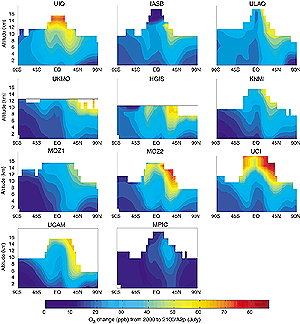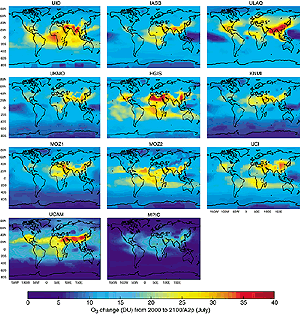4.4.4 Model Simulations of Perturbed and Y2100 Atmospheres
The OxComp workshop also defined a series of perturbations to the Y2000 atmosphere
for which the models reported the monthly averaged 3-D distribution of O3
abundances and the budget for CH4, specifically the loss due to reaction
with tropo-spheric OH. From these diagnostics, the research group at Oslo calculated
the change in global mean tropospheric O3 (DU) and in OH (%) relative
to Y2000, as shown in Table 4.11. For each model at every
month, the “troposphere” was defined as where O3 abundances
were less than 150 ppb in the Y2000 simulation, a reasonably conservative diagnostic
of the tropopause (see Logan, 1999). Because O3 is more effective
as a greenhouse gas when it lies above the surface boundary layer (SAR; Hansen
et al., 1997a; Prather and Sausen, 1999; Chapter 6 of
this report), the model study diagnosed the O3 change occurring in
the 0 to 2 km layers of the model. This amount is typically 20 to 25% of the
total change and is consistent across models and types of perturbations here.
| Table 4.11: Changes in tropospheric O3
(DU) and OH (%) relative to year 2000 for various perturbations to the atmosphere.
Individual values calculated with chemistry transport-models (CTMs) plus
the average values adopted for this report (TAR). |
 |
| |
Y2000
|
A2x: Y2100 -Y2000
|
| |
+10% CH4
|
All A2x
|
–NOx
|
–NOx–VOC–CH4
|
 |
| CTM |
Case A
|
Case B
|
Case C
|
Case D
|
 |
| Effectivea tropospheric O3 change
(DU): |
 |
| HGIS |
|
26.5
|
|
|
| GISS |
|
25.2
|
|
|
| IASB |
0.66
|
18.9
|
9.2
|
0.4
|
| KNMI |
0.63
|
18.0
|
9.0
|
|
| MOZ1 |
|
16.6
|
|
|
| MOZ2 |
|
22.4
|
|
|
| MPIC |
0.40
|
|
|
|
| UCI |
0.69
|
23.3
|
10.2
|
2.8
|
| UIO |
0.51
|
26.0
|
6.0
|
2.1
|
| UKMO |
|
18.9
|
4.6
|
3.1
|
| ULAQ |
0.85
|
22.2
|
14.5
|
5.9
|
| TARb |
0.64
|
22.0
|
8.9
|
2.0
|
 |
| Tropospheric OH change (%) |
 |
| IASB |
-2.9%
|
-7%
|
|
|
| KNMI |
-3.3%
|
-25%
|
-41%
|
|
| MOZ1 |
|
-21%
|
|
|
| MOZ2 |
|
-18%
|
|
|
| MPIC |
-2.7%
|
|
|
|
| UCI |
-3.2%
|
-15%
|
-39%
|
-16.0%
|
| UIO |
-3.1%
|
-6%
|
-37%
|
-12.3%
|
| UKMO |
-2.9%
|
-12%
|
-37%
|
-10.8%
|
| ULAQ |
-2.7%
|
-17%
|
-43%
|
-22.0%
|
| TARb |
-3.0%
|
-16%
|
-40%
|
-14%
|
 |
Case A, a +10% increase in CH4 abundance for Y2000, had consistent
results across reporting models that differed little from the SAR’s Delta-CH4
model study. The adopted values for this report are -3% change in OH and +0.64
DU increase in O3, as listed under the “TAR” row in Table
4.11.
The Y2100 atmosphere in OxComp mimics the increases in pollutant emissions in
SRES A2p scenario from year 2000 to year 2100 with the year 2100 abundance of
CH4, 4,300 ppb, calculated with the SAR technology and named here
A2x. (See discussion in section 4.4.5; for the SAR, only
the CH4-OH feedback is included.) The long-lived gases CO2
and N2O have no impact on these tropospheric chemistry calculations
as specified.
Cases B-C-D are a sequence of three Y2100 atmospheres based on A2x: Case B
is the full Y2100-A2x scenario; Case C is the same Y2100-A2x scenario but with
unchanged (Y2000) NOx emissions; and Case D is the same but with
NOx, VOC and CH4 unchanged since Y2000 (i.e., only CO
emissions change). Case B (Y2100-A2x) results are available from most OxComp
participants. All models predict a decrease in OH, but with a wide range from
-6 to -25%, and here we adopt a decrease of -16%. Given the different distributions
of the O3 increase from the OxComp models (Figures
4.12-13), the increases in globally integrated O3
were remarkably consistent, ranging from +16.6 to +26.5 DU, and we adopt +22
DU. Without the increase in NOx emissions (Case C) the O3
increase drops substantially, ranging from +4.6 to +14.5 DU; and the OH decrease
is large, -37 to -43%. With only CO emissions (Case D) the O3 increase
is smallest in all models, +0.4 to +5.9 DU.
This report adopts a weighted, rounded average of the changes in OH and O3
for cases A-D as shown in the bold rows in Table 4.11.
The weighting includes factors about model formulation and comparison with observations.
This sequence of calculations (Y2000 plus Cases A-B-C-D) allows us to define
a simple linear relationship for the absolute change in tropospheric O3
and the relative change in OH as a function of the CH4 abundance
and the emission rates for NOx, for CO, and for VOC. These two relationships
are given in Table 4.11. Since the change in CH4
abundance and other pollutant emissions for Y2100-A2x are among the largest
in the SRES scenarios, we believe that interpolation of the O3 and
OH changes for different emission scenarios and years introduces little additional
uncertainty.
The possibility that future emissions of CH4 and CO overwhelm the
oxidative capacity of the troposphere is tested (Case E, see Table
4.3 footnote c) with a +10% increase in CH4 on top of Y2100-A2x
(Case B). Even at 4,300 ppb CH4, the decrease in OH calculated by
two CTMs is only slightly larger than in Case A, and thus, at least for SRES
A2p, the CH4-feedback factor does not become as large as in the runaway
case (Prather, 1996). This report assumes that the CH4 feedback remains
constant over the next century; however, equivalent studies for the low-NOx
future scenarios are not assessed.
The apparent agreement on predicting the single global, annual mean tropospheric
O3 increase, e.g., Case B in Table 4.11, belies
the large differences as to where this increase occurs and what is its peak
magnitude. The spatial distributions of the tropospheric O3 increases
in July for Case B are shown in Figure 4.12 (latitude
by altitude zonal average abundance, ppb) and Figure 4.13
(latitude by longitude column density, DU) for nine CTMs. The largest increase
in abundance occurs near the tropopause at 40°N latitude; yet some models
concentrate this increase in the tropics and others push it to high latitudes.
In terms of column density, models generally predict large increases along the
southern edge of Asia from Arabia to eastern China; although the increases in
tropical, biomass-burning regions varies widely from model to model.

Figure 4.12: July zonal mean increase in tropospheric O3
(ppb) as a function of latitude and altitude from Y2000 to Y2100 adopting
SRES A2p projections for CH4, CO, VOC, and NOx.
Results are shown for a sample of the chemistry-transport models (CTM)
participating in IPCC OxComp workshop. Increases range from 0 to more
than 80 ppb. Changes in the stratosphere (defined as O3
> 150 ppb in that model’s Y2000 simulation) are masked off,
as are also regions in the upper troposphere for some CTMs (UKMO,
HGIS) where O3 is not explicitly calculated. See Table
4.10 for participating models. |
|

Figure 4.13: July column increase in tropospheric O3
(DU) as a function of latitude and longitude from Y2000 to Y2100 adopting
SRES A2p projections for CH4 , CO, VOC, and NOx
is shown for some OxComp simulations. See Figure
4.12. |
|
This similarity in the total, but difference in the location, of the predicted
O3 increases is noted in Isaksen and Jackman (1999) and is probably
due to the different transport formulations of the models as documented in previous
CTM intercomparisons (Jacob et al., 1997). Possibly, the agreement on the average
O3 increase may reflect a more uniform production of O3
molecules as a function of NOx emissions and CH4 abundance
across all models. Nevertheless, the large model range in the predicted patterns
of O3 perturbations leads to a larger uncertainty in climate impact
than is indicated by Table 4.11.
The projected increases in tropospheric O3 under SRES A2 and A1FI
will have serious consequences on the air quality of most of the Northern Hemisphere
by year 2100. Taking only the global numbers from Figure
4.14, the mean abundance of tropospheric O3 will increase from
about 52 ppb (typical mid-tropospheric abundances) to about 84 ppb in year 2100.
Similar increases of about +30 ppb are seen near the surface at 40°N on
a zonal average in Figure 4.12. Such increases will raise
the “background” levels of O3 in the northern mid-latitudes
to close to the current clean-air standard.
(tropospheric O3) = +5.0 x
ln(CH4) + 0.125 x
(e-NOx) + 0.0011 x
(e-CO) + 0.0033 x
(e-VOC) in DU.
ln(tropospheric OH) = -0.32 x
ln(CH4) + 0.0042 x
(e-NOx) - 1.05e-4 x
(e-CO) - 3.15e-4 x
(e-VOC).
(effective O3) = +6.7 x
ln(CH4) + 0.17 x
(e-NOx) + 0.0014 x
(e-CO) + 0.0042 x
(e-VOC) in DU.

